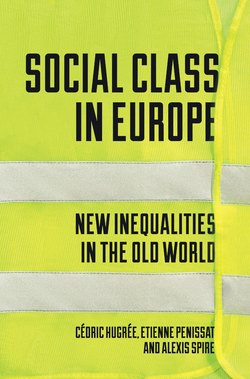Читать книгу Social Class in Europe - Étienne Penissat - Страница 14
На сайте Литреса книга снята с продажи.
BEYOND INCOME INEQUALITY
ОглавлениеThe depth of the 2008 financial and economic crisis put the issue of wealth differences between social groups back on the agenda. Thomas Piketty, in Capital in the Twenty-First Century, profoundly reworked an economic analysis which had, until then, been focused on differences in income: his book revealed that possession of assets – that is, capital that over the long term grows more rapidly than the production of added value – lies at the heart of contemporary inequalities.23 In the context of financial globalisation and weakening systems of social protection, wealth inequality becomes central. But power relations cannot be reduced to the action of a few ‘super-rich’ people whose income has skyrocketed compared to the rest of the population. They play out at many other levels on the social scale – between the foreman and his subordinate, or between the private-sector manager and her children’s babysitter – and they are constructed in all the various areas of social life. Moreover, defining inequality solely in terms of income tends to conceal not only the political power relations between social groups, but also the internal divisions within them.24 The notion of class allows us to distinguish not only the lack of resources or the dependence of the working class in relation to the middle class and the dominant class, but also an equally determining factor, what Olivier Schwartz calls the ‘assignment of low and subordinate status’ that is manifested in exclusion from the centres of economic, cultural and political power.25
Sociological analysis in terms of social class makes it possible to avoid reducing the study of inequality to the vertical and graded reading implied by scales of income or assets.26 Aside from everything that separates social groups, internal divisions within social classes are equally crucial in the reconfiguration of inequality today. Within the working class, for example, the contrast between skilled workers, the proportion of whom is declining, and unskilled workers, on the rise owing to the expansion of the teritary sector, is accompanied by differences in class consciousness and in political and cultural participation. Among the middle class, even after the New Public Management turn that applies new rules to the public sector, there are still differences in conditions of employment between employees in the two sectors, which have repercussions in many other areas of social life. Differences in the arena of work are matched by differing cultural practices, values and political orientations, and by different lifestyles altogether.27 Each ‘big class’ contains a large number of occupations, and this heterogeneity can obscure important divisions, but the ‘microclass approach’ cannot be clearly implemented at a European scale.28
What are the empirical bases for defining social classes? Some sociologists, following Marx, place the emphasis on position in the sphere of production, and hence on economic resources; others, on the basis of a rereading of Weber, focus on statutory position and the signifiers of cultural and symbolic differentiation. In his work, Pierre Bourdieu attempted to combine these approaches, distinguishing class-fractions on the basis of their relative economic and cultural capital.29 In this book, we draw on this multidimensional approach to describe the social space in Europe, taking the view that the term ‘class’ refers to the combination of economic and cultural capitals that construct both the socially and economically dominated positions of certain social groups and the forms of separation, distinction and cultural boundaries between them. The term can then be used as an overarching indicator of inequalities in standard of living (cultural practices, consumption, housing, access to health, etc.), employment and work. In statistical studies, this class position was for a long time measured in terms of individuals’ occupation and employment status (employed or self-employed), in order to account for both their economic and their cultural resources. However, this representation of the social world has been subject to considerable criticism over the last twenty years.
Some writers point out that, in societies hit by unemployment and precarity, the crucial division is between insiders and outsiders, those included in and excluded from employment. Others, who take the view that occupation is increasingly less useful in explaining social behaviours, have developed more complex approaches based on multiple indicators. The British sociologist Mike Savage and his team, for example, suggest that individuals’ financial resources, cultural practices (tastes in music, new technology practices, etc.) and their social capital (their network of relations) should be combined in a new analysis of class in the United Kingdom.30 At the European level, it is not yet possible to reproduce this approach, since current statistical surveys do not include questions that would allow these three types of capital to be measured. Moreover, assigning individuals to a given social class on the basis of their cultural practices (for example, the use of new technology) can tend to distinguish age groups – ‘young’ fans of hip hop and NICT (new information and communication technologies) as against ‘older people’ who love rock and are less comfortable with NICT – rather than social classes.
In fact, as recent studies show, occupation remains a useful tool for shedding new light on inequalities between citizens and their way of life.31 It is still a determining factor, even when individuals have no job – or are no longer in formal employment. The unemployed vote, for example, is not homogeneous, and is linked much more to differences in social affiliation (most recent job), social origin (parents’ profession) and level of education than to the fact of being unemployed. The same is true of pensioners, whose social practices remain largely determined by the position they held in the labour market.
